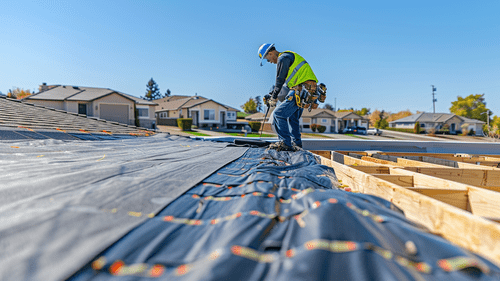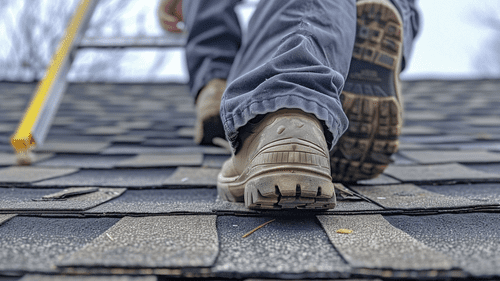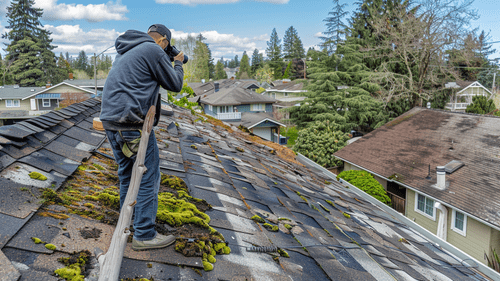Year-Round Roof Maintenance: A Guide for Homeowners in the United States
As the seasons change, your roof faces a unique set of challenges that can affect its integrity and longevity. Have you ever wondered how winter’s icy grip or summer’s relentless sun can impact your home’s first line of defense? Regular roof inspections are key to addressing these seasonal hurdles and ensuring your roof remains in top condition. Understanding the specific needs your roof has throughout the year helps prevent minor issues from turning into major headaches.
In this guide, we’ll walk you through essential tips for preparing your roof each season. From spotting winter damage in spring to fortifying against summer’s heat, we’ve got you covered. Curious about when to call in the professionals or how to handle storm preparedness? We’ll cover that too. Our focus is on providing you with the knowledge to maintain your roof efficiently and safely, all while supporting local services that share our commitment to integrity and community. Let’s get you the peace of mind that comes with a well-cared-for roof.
1. Preparing for Spring: Post-Winter Recovery
Identifying Winter Damage
As winter recedes, your roof may reveal the toll taken by months of snow, ice, and freezing temperatures. One common issue is ice dams, which occur when melting snow refreezes at the roof’s edge, preventing proper drainage. This can lead to water seeping under shingles and causing leaks. The freeze-thaw cycle can also lead to cracks in roofing materials. Identifying these problems early is crucial to preventing further damage.
The weight of accumulated snow can also stress the roof structure. While roofs are designed to bear specific loads, unusual snow accumulation might surpass these limits, resulting in potential structural compromise. Assessing the snow load impact should include checking for sagging areas or weakened support beams. This inspection ensures that any immediate structural threats are addressed before they escalate.
Spring Cleaning Essentials
Spring is the ideal time for a thorough roof cleaning, which includes removing debris and checking the gutters. Winter storms often leave behind branches, leaves, and other debris that can clog gutters. This blockage impedes proper drainage and can lead to water pooling and potential roof leaks.
Shingles and flashings also require close examination. Winter weather can loosen or damage these components, leading to vulnerabilities. Look for curling, cracking, or missing shingles and inspect flashings around chimneys and vents to ensure they remain intact and secure. Regular maintenance of these elements is key to sustaining the roof’s protective function.
Professional Support: When to Call an Expert
Certain signs of damage necessitate the expertise of a professional. If water stains appear on interior ceilings or walls, this indicates a possible roof leak that requires immediate attention. Similarly, sagging or visible structural damage should be evaluated by a professional to determine the extent of repairs needed.
Professional roof inspections offer comprehensive assessments that go beyond surface-level inspections. Experts can detect hidden issues, such as moisture infiltration or weakened structural components, ensuring that all problems are addressed. This detailed service not only preserves the roof’s integrity but also extends its lifespan.
2. Summer Maintenance: Heat and UV Protection
Addressing Sun Damage
Summer’s intense heat and UV rays can be harsh on roofing materials, causing them to deteriorate faster. Signs of UV damage include faded or discolored shingles and brittleness, which can lead to cracking or splitting. To mitigate these effects, proper ventilation and reflective coatings are essential. Ventilation helps maintain a cooler roof temperature, reducing heat stress on materials, while reflective coatings can deflect sunlight, prolonging the roof’s durability.
Proper attic ventilation is also crucial since it helps regulate indoor temperatures, reducing energy costs and preventing moisture buildup. This ensures that the roof remains in good condition, protecting the home from extreme summer conditions.
Storm Preparedness
Summer storms, often accompanied by high winds and heavy rain, pose additional risks to roof integrity. Inspect roof components like shingles, tiles, and flashings to ensure they are securely fastened. Loose materials can become projectiles in strong winds, leading to further damage.
Roof accessories, such as vents and skylights, should also be checked for secure installation and proper sealing. Ensuring these elements are robustly installed reduces the risk of leaks and structural damage during storms. Routine maintenance of these components is vital for a storm-resistant roof.
Community Engagement: Supporting Local Services
Local roofing services often provide specialized knowledge and personalized care that larger companies may not offer. These services are rooted in the community and understand regional challenges, making them adept at addressing specific roofing needs. Supporting local businesses not only ensures quality service but also strengthens the community as a whole.
Participating in community-focused roof maintenance programs offers homeowners benefits such as discounts or free inspections. Such initiatives exemplify a commitment to service and trustworthiness, reinforcing the importance of community engagement in roof care.
3. Autumn Readiness: Prepping for a Smooth Transition
Leaf and Debris Management
As autumn arrives, falling leaves and organic debris become prevalent, potentially clogging gutters and downspouts. This blockage can lead to water backup and overflow, risking water damage to both the roof and the home’s foundation. Regular cleaning of gutters is essential to prevent such issues.
- Regularly clean gutters to prevent blockages.
- Implement effective debris management strategies to ensure optimal roof drainage.
Organic debris can also trap moisture against roofing materials, accelerating deterioration. This is particularly problematic for roofs with poor drainage, as constant moisture exposure can lead to mold and rot.
Moisture Control
Autumn is an opportune time to address potential leak areas before the wet season sets in. Sealing gaps around chimneys, vents, and skylights prevents water infiltration. Ensuring attic insulation and ventilation is in good condition also aids in moisture control, reducing the risk of mold growth and structural decay.
Proper insulation not only aids in moisture management but also enhances energy efficiency. A well-insulated attic helps maintain a consistent indoor temperature, reducing heating costs during cooler months. This proactive approach to moisture control safeguards the roof and boosts overall home efficiency.
Efficient Planning: Streamlining Inspections
Scheduling regular roof inspections is a proactive measure that can avert costly repairs. By establishing a routine inspection schedule, homeowners can detect and address issues before they escalate. This practice minimizes unexpected repairs and extends the roof’s lifespan.
Routine checks allow for timely maintenance, keeping the roof in optimal condition year-round. Homeowners should consider creating a checklist for seasonal inspections, ensuring no aspect is overlooked. This organized approach to roof care reflects a commitment to stewardship and responsible maintenance.
4. Winter Preparations: Defense Against Harsh Conditions
Strengthening Roof Durability
Winter presents unique challenges that require specific preparations. Reinforcing vulnerable areas, such as eaves and valleys, helps prevent ice and snow buildup. Ensuring proper roof insulation is another critical step, as it enhances energy efficiency and reduces heating costs.
Improving insulation not only keeps the home warmer but also helps prevent ice dams. By keeping the roof surface below freezing, ice dams are less likely to form, reducing the risk of water damage. These preparations ensure the roof withstands the harshest winter conditions.
Safety Measures
Winter inspections and maintenance can be hazardous, requiring adherence to strict safety protocols. Homeowners should ensure safe access to the roof and use appropriate safety gear when conducting inspections. Professional services can provide safer, more comprehensive inspections, particularly in inclement weather.
For those undertaking DIY maintenance, understanding the limits of personal safety is paramount. Simple tasks like removing snow should be done with caution, using tools designed to minimize risk. These safety measures ensure roof care is conducted without compromising personal well-being.
Ethical Practices: Stewardship and Integrity in Roof Care
Responsible roof maintenance embodies a commitment to ethical practices and integrity. This involves using quality materials, following industry standards, and providing accurate assessments without upselling unnecessary services. Ethical inspections prioritize the homeowner’s needs, ensuring transparency and trust.
Promoting stewardship in roof care means maintaining the roof not only for immediate needs but also considering long-term impacts. This approach aligns with sustainable practices, ensuring roofs are maintained efficiently and responsibly. Emphasizing these values fosters a culture of integrity in the roofing industry.
Conclusion: Ensuring Year-Round Roof Resilience
Maintaining your roof’s integrity through every season involves a proactive approach that anticipates and prevents potential damage. From the icy challenges of winter to the scorching demands of summer, understanding your roof’s needs and reinforcing its defenses is essential. Engaging with local services ensures personalized care and strengthens community ties, highlighting the importance of stewardship and integrity in home maintenance.
As we wrap up, remember that a well-maintained roof represents responsible homeownership and community solidarity. Prioritizing regular inspections and embracing ethical practices safeguards your investment and contributes to an environment where quality and trust prevail. So, the next time you look up at your roof, consider the deeper implications of its care. Are you ready to take the next step in ensuring its resilience?







